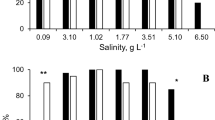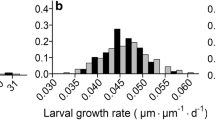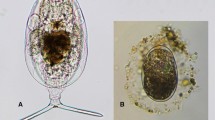Abstract
Daphnia hyalina is a cladoceran present throughthe whole year except for late summer in Maranhão,a meso-eutrophic reservoir in central Portugal. Apartfrom the influence of food, both vertebrate andinvertebrate predation pressures seem to have aneffect on D. hyalina population dynamics.Enclosure experiments were designed to assess therelative importance of both types of predation. Afterthe summer crash, D. hyalina reached highernumbers in the fishless enclosures than in the lakedespite of high predation pressure upon juveniles byAcanthocyclops robustus. Fish predation upon thelargest individuals, especially large egg bearingfemales, was responsible for the lower fertility ofthe open water population when compared with theenclosure population. In the enclosures an increase intail spine length was observed. The longer tail spineprobably offered protection from copepod predation,allowing at least some of the juveniles to coexistwith their potential predator and reach the adultstage, less susceptible to copepod predation.
Similar content being viewed by others
References
Balseiro, E. G. & M. Vega, 1994. Vulnerability of Daphnia middendorffiana to Parabroteas sarsipredation: the role of the tail spine. J. Plankton Res. 16: 783–793.
Boersma, M., 1995a. Competition in natural populations of Daphnia. Oecologia 103: 309–318.
Boersma, M., 1995b. The allocation of resources to reproduction in Daphnia galeata: against the odds? Ecology 76: 1251–1261.
Brandl, Z. & C. H. Fernando, 1975. Investigations on the feeding of carnivorous cyclopoids. Verh. int. Ver. Limnol. 19: 2959–2965.
Brandl, Z. & C. H. Fernando, 1986. Feeding and food consumption by Mesocyclops edax. Proc. Second Int. Conf. on Copepoda, Natl. Mus. Nat. Sciences Canada, Syllogeus No. 58: 254–258.
Bottrell, H. H., A. Duncan, Z. M. Gliwicz, F. Grygierek, A. Herzig, A. Hillbricht-Ilkowska, A. Kurasawa, P. Larsson & T. Weglenska, 1976. A review of some problems in zooplankton studies. Norw. J. Zool. 24: 419–456.
Dodson, S. I., 1974. Adaptive change in plankton morphology in response to size selective predation: A new hypothesis of cyclomorphosis. Limnol. Oceanogr. 19: 721–729.
Gliwicz, Z. M., 1981. Food and predation in limiting clutch size of cladocerans. Verh. int. Ver. Limnol. 21: 1562–1566.
Gliwicz, Z. M. & W. Lampert, 1993. Body-size related survival of cladocerans in a trophic gradient: An enclosure study. Arch. Hydrobiol. 129: 1–23.
Gliwicz, Z. M. & J. Pijanowska, 1989. The role of predation in zooplankton succession. In U. Sommer (ed.), Plankton Ecology. Springer-Verlag, Berlin: 253–296.
Gliwicz, Z. M. & G. Umana, 1994. Cladoceran body size and vulnerability to copepod predation. Limnol. Oceanogr. 39: 419–424.
Grant, J. W. G. & I. A. E. Bayly, 1981. Predator induced crests in morphs of the Daphnia carinataKing complex. Limnol. Oceanogr. 15: 721–729.
Haney, J. F. & C. Buchanan, 1987. Distribution and biogeagraphy of Daphniain the arctic. In R. H. Peters & R. DeBernardi (eds), Daphnia. Mem. Ist. Ital. Idrobiol. 45: 77–105.
Harbácek, J., 1977. Competition and predation in relation to species composition of freshwater zooplankton, mainly Cladocera. In J. J. Cairns (ed.), Aquatic Microbial Communities. Garland Publishing, Inc., New York: 308–353.
Havel, J. E., 1985. Cyclomorphosis of Daphnia pulexspinedmorphs. Limnol. Oceanogr. 30: 853–861.
Havel, J. E. & S. I. Dodson, 1984. Chaoboruspredation on typical and spined morphs of Daphnia pulex: Behavioral observations. Limnol. Oceanogr. 29: 487–494.
Horn, W., 1985. Investigations into the food selectivity of the planktic crustaceans Daphnia hyalina, Eudiaptomus gracilisand Cyclops vicinus. Int. Revue ges. Hydrobiol. 70: 603–612.
Li, J. L. & H. W. Li, 1979. Species-specific factors affecting predator-prey interactions of the copepod Acanthocyclops vernaliswith its natural prey. Limnol. Oceanogr. 24: 613–626.
Lüning, J., 1992. Phenotypic plasticity of Daphnia pulexin the presence of invertebrate predators: morphological and life history responses. Oecologia 92: 383–390.
Lüning, J., 1995. Life-history responses to Chaoborusos spined and unspined Daphnia pulex.J. Plankton Res. 17: 71–84.
Marinone, M. A. & H. E. Zagarese, 1991. A field and laboratory study on factors affecting polymorphism in the rotifer Keratella tropica. Oecologia 86: 372–377.
Mort, M., 1986. Chaoboruspredation and the function of phenotypic variation in Daphnia. Hydrobiologia 133: 39–44.
Paloheimo, J. E., 1974. Calculation of instantaneous birth rate. Limnol. Oceanogr. 19: 692–694.
Polishchuk, L. V., 1994. Cladoceran birth rate dynamics: does population characteristic analysis reflect environmental control? Verh. int. Ver. Limnol. 25: 2369–2371.
Polishchuk, L. V., 1995. Direct positive effect of invertebrate predators on birth rate in Daphniawith a new method of birth rate analysis. Limnol. Oceanogr. 40: 483–489.
Smyly, W. J. P., 1970. Observations on the rate of development, longevity and fecundity of Acanthocyclops viridis(Jurine) (Copepoda, Cyclopoida) in relation to type of prey. Crustaceana 18: 21–36.
Stemberger, R. S. & J. J. Gilbert, 1984. Spine development in the rotifer Keratella cochlearis: induction by cyclopoid copepods and Asplanchna. Freshwat. Biol. 14: 639–647.
Taylor, B. E. & W. Gabriel, 1992. To grow or not to grow: optimal resource allocation for Daphnia. Am. Nat. 139: 248–266.
Vanni, M. J., 1987. Effects of food availability and fish predation on a zooplankton community. Ecol. Monogr. 57: 61–88.
Williamson, C. E., 1983. Behavioral interactions between a cyclopoid copepod predator and its prey. J. Plankton Res. 5: 701–711.
Zaret, T., 1980. Predation in freshwater communities. Yale University Press, New Haven, Connecticut, 187 pp.
Author information
Authors and Affiliations
Rights and permissions
About this article
Cite this article
Caramujo, MJ., Crispim, M.C. & Boavida, MJ. Assessment of the importance of fish predation versus copepod predation on life history traits of Daphnia hyalina. Hydrobiologia 360, 243–252 (1997). https://doi.org/10.1023/A:1003171828299
Issue Date:
DOI: https://doi.org/10.1023/A:1003171828299




